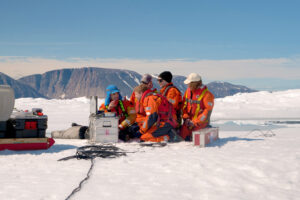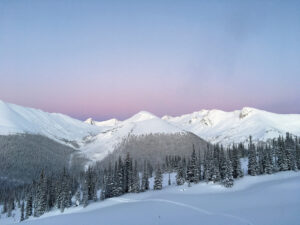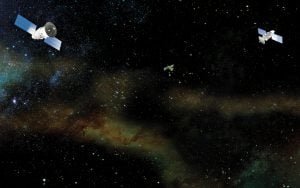
Environment
Hopes for the first field school on Arctic snow
Researchers, students and hunters are coming together in Iqaluktuuttiaq (Cambridge Bay) to learn from each other about snow in the High Arctic.
- 1137 words
- 5 minutes
This article is over 5 years old and may contain outdated information.
Science & Tech

With climbing skins on his skis, James Floyer ascends a backcountry slope in British Columbia’s Glacier National Park. Stopping for a moment, he reaches into his backpack and pulls out a three-metre-long collapsible avalanche probe. Every few metres, he inserts it into the snowpack, feeling for inconsistencies that will alert him to weak layers that could potentially lead to an avalanche. For Floyer, a senior avalanche forecaster with the Canadian Avalanche Centre in Revelstoke, B.C., this activity — along with shovelling study pits, measuring the depth of the snow with a ruler and examining it with a magnifying glass — is a time-honoured, industry-standard and laborious method of assessing snowpack stability.
But the way glaciologists, snow hydrologists, climatologists and avalanche professionals such as Floyer gather information may soon become more efficient, thanks to a new device that uses sonar technology.
The System for the Acoustic Sensing of Snow (SAS2) — a prototype developed by Nicholas Kinar (above, at left), a Ph.D. candidate at the University of Saskatchewan’s Centre for Hydrology — is a textbook-sized circuit board carried in a cross-country-skiing child buggy. As Kinar pushes the buggy across the surface of the snow, he periodically presses a button, causing a saucer-sized speaker to send sound waves into the snowpack. Twentyfour tiny microphones detect the sound bouncing back, and that information is then plugged into a mathematical model that can determine details such as snow depth, density, temperature and wetness. There’s no probing, no digging and no altering of the snowpack whatsoever. “Snowpack sampling is an art, and I’m all thumbs,” says Kinar. “I’m trying to take away the uncertainty and eliminate the work of digging into the snowpack.”
Potential developments include miniaturizing the device to attach to a ski pole, enabling a reading with every pole plant. It could also be programmed to communicate with a smartphone, mounted on a robot to cover areas too large for a manual survey and help scientists develop models to reduce uncertainty around water resources and climate-change predictions. And while Floyer doesn’t see the SAS2 replacing the transceivers used to locate buried avalanche victims equipped with a beacon, he notes that it might help find the bodies of people not equipped with such a device. “I applaud Kinar’s work,” he says. “A small unit that fits in a pocket would be a very exciting development.”
Kinar’s work on SAS2 has already made him the first person to be awarded the top graduate student hydrology award from both the Canadian Geophysical Union and the American Geophysical Union, and others are bound to notice his work, notes Danny Marks, a research hydrologist with the United States Department of Agriculture’s Northwest Watershed Research Center in Boise, Idaho. “Nicholas has created a device that’s small, cheap and quicker than a team of shovellers,” he says. “That’s gold.”
Are you passionate about Canadian geography?
You can support Canadian Geographic in 3 ways:

Environment
Researchers, students and hunters are coming together in Iqaluktuuttiaq (Cambridge Bay) to learn from each other about snow in the High Arctic.

Travel
At British Columbia’s Purcell Mountain Lodge, guests can partake in skiing and snowshoeing and then end the day with a well-deserved three-course dinner

Wildlife
Snowy owls have evolved to survive the harsh environment of the Arctic tundra, but can they survive its warming?

Science & Tech
As geotracking technology on our smartphones becomes ever more sophisticated, we’re just beginning to grasps its capabilities (and possible pitfalls)